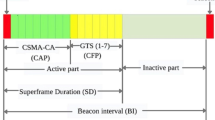Abstract
This paper considers the internetwork interference problem in environments with multiple wireless body area networks (WBANs). We propose an asynchronous internetwork interference avoidance scheme (abbreviated as AIIA), which is based on the hybrid multiple access of carrier sense multiple access with collision avoidance (CSMA/CA) and time division multiple access (TDMA). In AIIA, the gateway device of each WBAN maintains a table, called an AIIA table, which includes the timing offset and TDMA transmission schedule information corresponding to the interfering WBANs. By referring to the table, the conflicting TDMA schedule can be checked and updated by itself, in asynchronous and distributed manners. Extensive simulations are conducted to demonstrate the feasibility and effectiveness of AIIA.














Similar content being viewed by others
References
Latre B, Braem B, Moerman I, Blondia C, Demeester P (2011) A survey on wireless body area networks. Wirel Netw 17(1):1–18
Kwak KS, Ullah S, Ullah N (2010) An overview of IEEE 802.15.6 standard. In: Proc ISABEL 2010, pp 1–6, Nov 2010
IEEE Std 802.15.6, wireless body area networks. IEEE Computer Society, Feb 2012
Tachtatzis C, Franco FD, Tracey DC, Timmons NF, Morrison J (2010) An energy analysis IEEE 802.15.6 scheduled access modes. In: Proc GLOBECOM 2010, pp 1270–1275, Dec 2010
Comaniciu C, Wang D, Minn H, Al-Dhahir N (2007) A game theoretic solution for exploiting multiuser diversity in cooperative slotted Aloha. In: Proc ICC 2007, pp 6085–6090, Jun 2007
Cagalj M, Ganeriwal S, Aad I, Hubaux J-P (2005) On selfish behavior in CSMA/CA networks. In: Proc INFOCOM 2005, pp 2513–2524, Mar 2005
IEEE Std 802.15.4 2006 (2006) Wireless medium access control and physical layer specifications for low-rate wireless personal area networks. IEEE Computer Society
Ye W, Heidemann J, Estrin D (2002) An energy-efficient MAC protocol for wireless sensor networks. In: Proc INFOCOM 2002, pp 1567–1576, Jun 2002
Dam T, Langendoen K (2003) An adaptive energy-efficient MAC protocol for wireless sensor networks. In: Proc SenSys 2003, pp 171–180, Nov 2003
Polastre J, Hill J, Culler D (2004) Versatile low power media access for wireless sensor networks. In: Proc SenSys 2004, pp 95–107, Nov 2004
Ergen SC, Varaiya P (2006) PEDAMACS: power efficient and delay aware medium access protocol for sensor networks. IEEE Trans Mob Comput 5(7):920–930
Hoesel L, Havinga P (2004) A lightweight medium access protocol (LMAC) for wireless sensor networks: reducing preamble transmissions and transceiver state switches. In: Proc INSS 2004, Jun 2004
Halkes G, Langendoen K (2007) Crankshaft: an energy-efficient MAC-protocol for dense wireless sensor networks. In: Proc EWSN 2007, pp 228–244, Jan 2007
Shon T, Kim E-J, In J, Park Y (2010) Design and implementation of hybrid MAC-based robust architecture for wireless sensor network. IEICE Trans Commun E93-B(4):1016–1019
Kim E-J, Youm S, Kang C-H (2011) Power-controlled topology optimization and channel assignment for hybrid MAC in wireless sensor networks. IEICE Trans Commun E94-B(9):2461–2472
Kim E-J, Shon T, Park JJH, Kang C-H (2012) Latency bounded and energy efficient MAC for wireless sensor networks. IET Commun 6(14):2120–2127
Kazemi R, Vesilo R, Dutkiewicz E, Fang G (2010) Inter-network interference mitigation in wireless body area networks using power control games. In: Proc ISCIT 2010, pp 81–86, Oct 2010
Kim E-J, In J, Youm S, Kang C-H (2012) Delay attack-resilient clock synchronization for wireless sensor networks. IEICE Trans Inf Syst E95-D(1):188–191
Qualnet Version 5.0. [Online]. Available. www.scalable-networks.com
Acknowledgements
This research was supported by the KCC (Korea Communications Commission), Korea, under the R&D program supervised by the KCA (Korea Communications Agency) (KCA-2011-08913-04002).
Author information
Authors and Affiliations
Corresponding authors
Rights and permissions
About this article
Cite this article
Kim, EJ., Youm, S., Shon, T. et al. Asynchronous inter-network interference avoidance for wireless body area networks. J Supercomput 65, 562–579 (2013). https://doi.org/10.1007/s11227-012-0840-4
Published:
Issue Date:
DOI: https://doi.org/10.1007/s11227-012-0840-4




